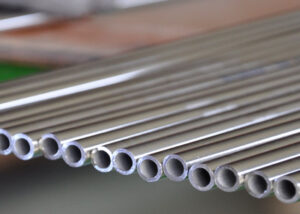Introduction
Stainless steel, celebrated for its durability and versatility, is not immune to the effects of oxidation. Among the diverse array of stainless steel grades, 410 stainless steel takes center stage as a compelling candidate, poised between strength and corrosion resistance. In this comprehensive exploration, we delve into the intricacies of 410 stainless steel’s oxidation resistance, shedding light on its composition, behavior, protective mechanisms, and applications.
The Oxidation Odyssey: Deciphering the Process
 Oxidation, a natural process, transforms metals in the presence of oxygen. Stainless steel’s innate resistance to corrosion often extends to oxidation, but the specific behavior varies across grades. The journey through oxidation uncovers the intricate dance between material, environment, and time.
Oxidation, a natural process, transforms metals in the presence of oxygen. Stainless steel’s innate resistance to corrosion often extends to oxidation, but the specific behavior varies across grades. The journey through oxidation uncovers the intricate dance between material, environment, and time.
Deconstructing the Composition of 410 Stainless Steel
The elemental composition of stainless steel shapes its oxidation resistance. 410 stainless steel, a martensitic grade, exhibits a unique composition enriched with carbon and chromium—a combination that influences its response to oxidation.
Understanding Oxidation Mechanisms
Oxidation isn’t a singular process—it’s a complex interplay of chemical reactions. In stainless steel, oxidation involves the formation of oxides on the surface, which can either act as protective barriers or give way to further degradation.
Oxidation Resistance of 410 Stainless Steel
410 stainless steel boasts respectable oxidation resistance, attributed to its chromium content. The formation of a chromium-rich oxide layer on the surface acts as a shield, thwarting further oxidation and enhancing longevity.
Protective Measures: The Role of Chromium
Chromium, a stalwart element in stainless steel, is the unsung hero of oxidation resistance. Its affinity for oxygen fosters the creation of a passive oxide layer—a barrier against further oxidation and a guardian of the alloy’s integrity.
High-Temperature Performance: Walking the Heat
The oxidation resistance of 410 stainless steel extends to high-temperature environments. Its ability to maintain structural stability and preserve the protective oxide layer under elevated heat levels reinforces its utility in diverse applications.
Real-World Applications: Oxidation Challenges and Solutions
 410 stainless steel’s oxidation resistance finds applications across industries:
410 stainless steel’s oxidation resistance finds applications across industries:
- Automotive Engineering: Exhaust systems endure high temperatures and aggressive environments.
- Heat Exchangers: Thermal applications demand oxidation-resistant materials.
- Industrial Furnaces: Oxidation-resistant alloys endure the rigors of extreme heat.
Comparative Analysis: Oxidation Resistance Across Stainless Steel Grades
Comparing oxidation resistance across stainless steel grades unveils differences:
- Austenitic Grades (e.g., 304 and 316): High chromium content contributes to oxidation resistance.
- Ferritic Grades: Oxidation resistance can vary based on chromium content and other factors.
Engineering Excellence: Optimizing Oxidation Performance
Engineers and designers play a pivotal role in optimizing oxidation performance. Material selection, protective coatings, and temperature management strategies contribute to enhancing oxidation resistance in specific applications.
FAQs About the Oxidation Resistance of 410 Stainless Steel
Q1: Can 410 stainless steel withstand extreme temperatures?
Yes, 410 stainless steel’s oxidation resistance allows it to endure high temperatures in various applications, making it a suitable choice for environments with elevated heat levels.
Q2: Can oxidation be prevented entirely in 410 stainless steel?
While the formation of a protective oxide layer mitigates oxidation, preventing it entirely might not be possible, especially under severe conditions. Proper material selection and protective measures are essential.
Q3: Does the thickness of the oxide layer impact oxidation resistance?
Yes, a thicker and more continuous oxide layer generally correlates with better oxidation resistance, as it acts as a more effective barrier against further oxidation.
Conclusion
The exploration of 410 stainless steel’s oxidation resistance unveils a symphony of composition, protection, and performance. Its ability to withstand oxidation in high-temperature environments echoes the alloy’s versatility and durability. Understanding the mechanisms behind oxidation resistance empowers engineers to wield 410 stainless steel strategically, crafting solutions that endure the challenges of time and environment.
